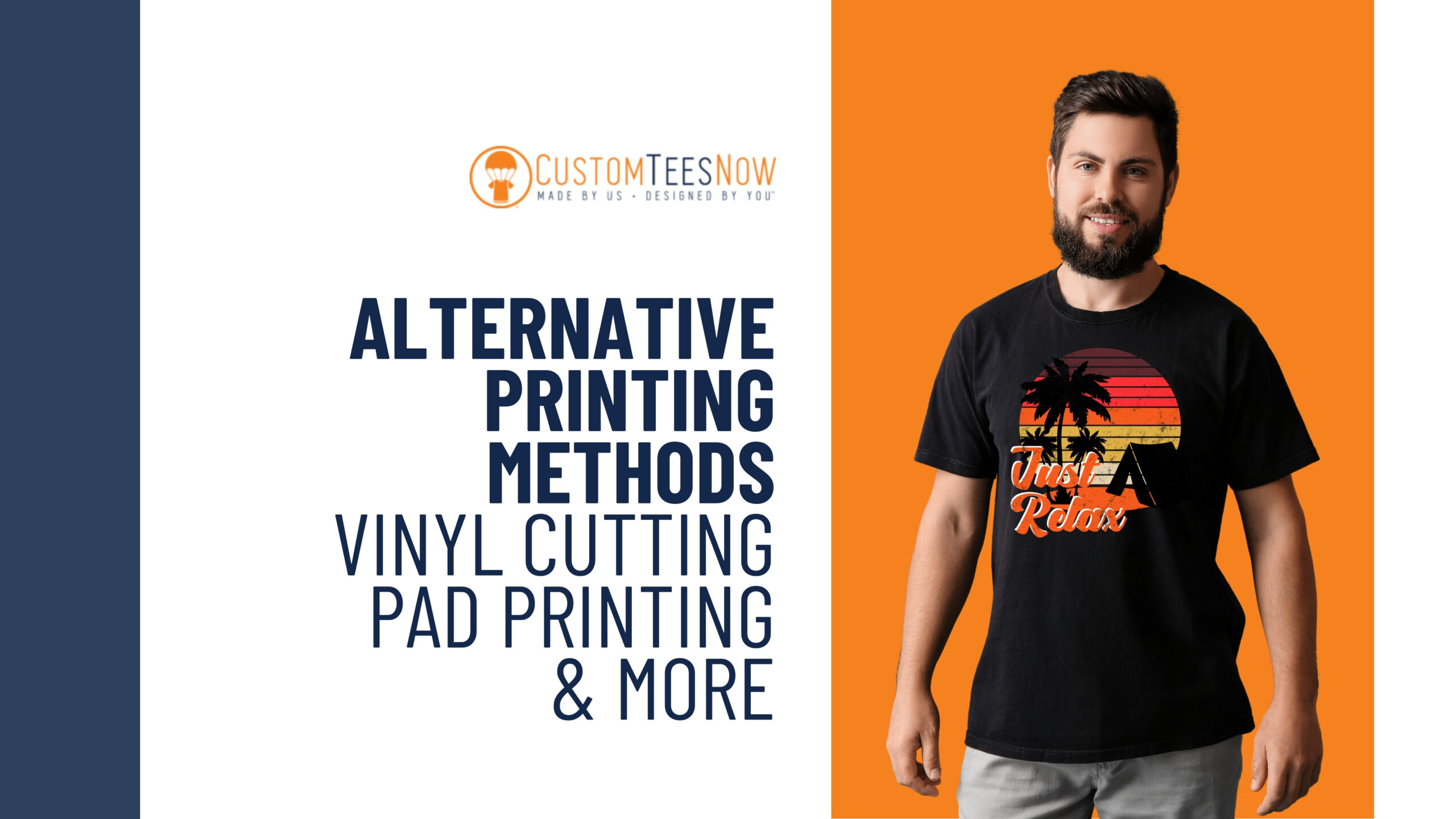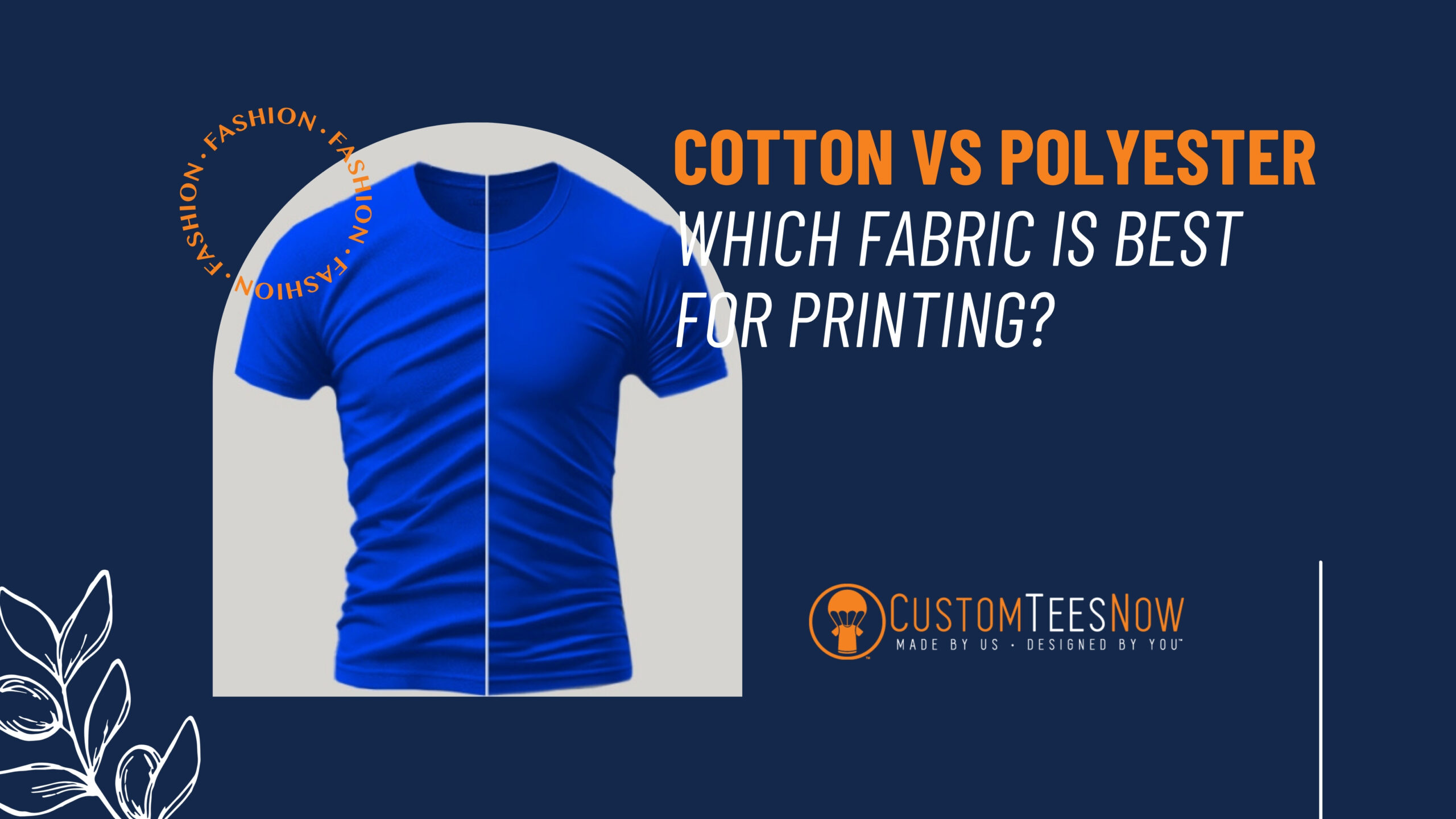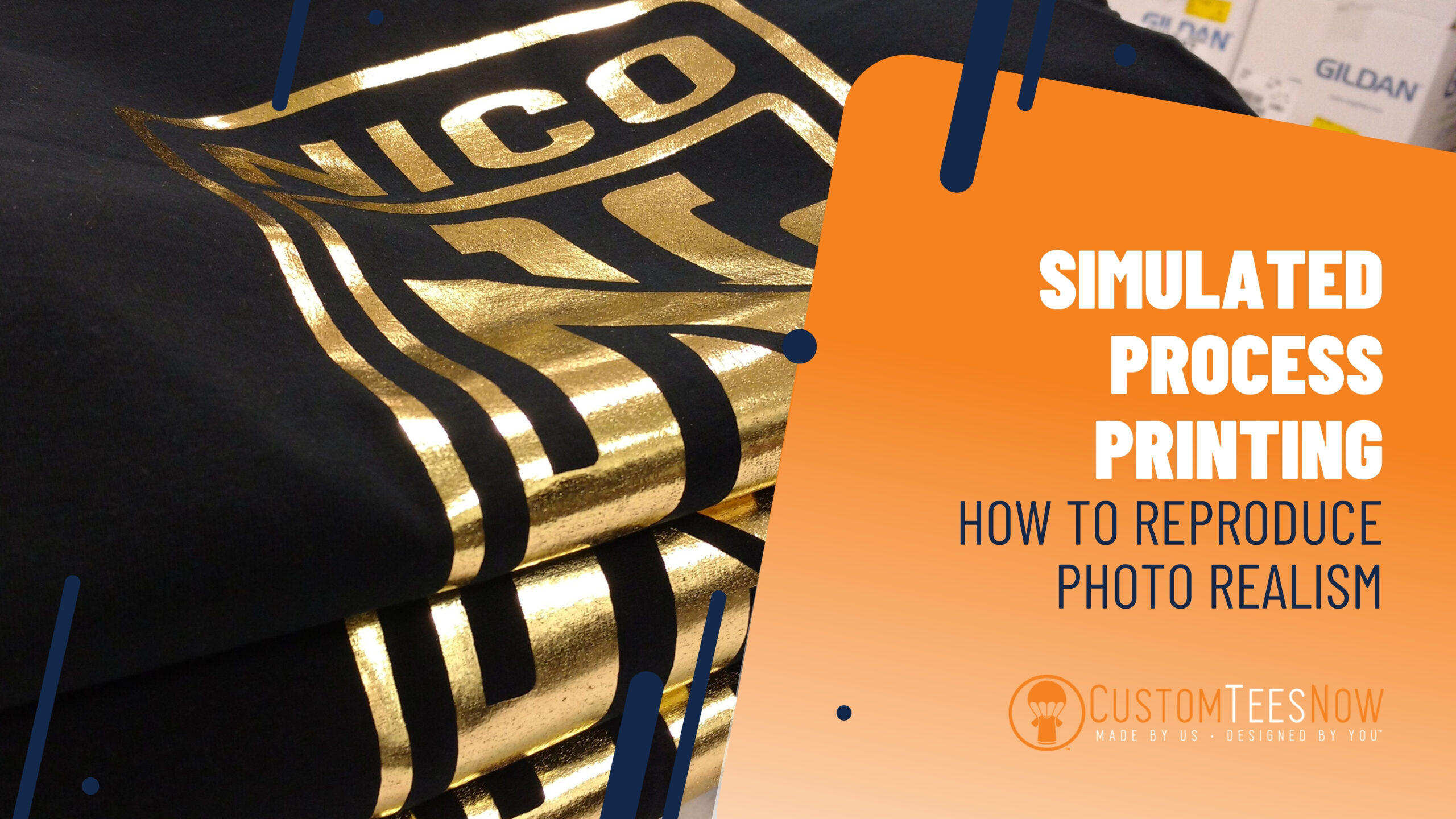
- October 24, 2025
Alternative Printing Methods: Vinyl Cutting, Pad Printing & More
In the ever-evolving landscape of custom apparel, traditional methods like screen printing and Direct-to-Garment (DTG) printing dominate, but innovative alternatives are gaining traction for their versatility, cost-effectiveness, and unique applications. If you’re searching for alternative printing methods for custom t-shirts and apparel, look no further. This guide explores vinyl cutting, pad printing, and other cutting-edge techniques like sublimation and Direct-to-Film (DTF), empowering you to diversify your offerings and meet diverse client needs.
At Custom Tees Now in Naples, FL, we harness these alternative printing techniques to deliver everything from personalized event tees to branded corporate wear. With the custom apparel market projected to surpass $10 billion by 2026, savvy printers are turning to these methods to reduce setup times, handle small runs efficiently, and achieve eye-catching results on non-traditional surfaces. Searches for “vinyl cutting for apparel” and “pad printing alternatives” have spiked 45% over the past year, underscoring the demand for flexible solutions that enhance creativity and profitability.
Whether you’re a startup navigating budget constraints or an established shop seeking to expand capabilities, understanding these alternative printing methods is crucial. We’ll break down the processes, pros, cons, and best-use scenarios, complete with practical tips and a comparison table. By the end, you’ll be equipped to select the ideal method for your next project, driving higher customer satisfaction and repeat business. Ready to create bold vinyl designs? Start with our custom t-shirt printing services. Let’s explore how these innovations can transform your custom apparel game.
Why Explore Alternative Printing Methods?
Before diving into specifics, consider why alternative printing methods matter in today’s market. Screen printing excels at high-volume, multicolor jobs but falters with intricate details or small quantities due to the cost of screens. DTG shines for photorealistic designs on cotton but struggles with synthetics and requires pre-treatment, adding complexity.
Alternatives like vinyl cutting and pad printing fill these gaps by offering speed, affordability, and adaptability. They cater to niche demands: think tagless labels on athletic wear or durable graphics on curved accessories. These methods also promote sustainability—many use less water and generate less waste than traditional setups.
Key drivers include:
- Cost Savings: Lower upfront equipment costs and no per-color fees.
- Versatility: Applicable to fabrics, plastics, and odd shapes.
- Speed: Ideal for on-demand production, reducing lead times to hours.
- Customization: Perfect for personalization in e-commerce booms.
A 2024 Printing Industries of America report notes that 35% of shops adopting alternatives saw a 20% uptick in order fulfillment speed. For businesses like yours, integrating these alternative apparel printing methods means staying competitive, minimizing downtime, and delighting clients with fresh options.
Vinyl Cutting: Precision and Personalization for Custom Designs
Vinyl cutting, often synonymous with Heat Transfer Vinyl (HTV), is a staple alternative printing method for creating bold, textured graphics on apparel. This technique uses a computer-controlled cutter to cut intricate designs from colored vinyl sheets, which are then heat-pressed onto fabric for a permanent bond.
How Vinyl Cutting Works
The process begins with design software like Adobe Illustrator or Cricut Design Space, where you create or import vector files. The cutter—such as a Cricut Maker or Roland machine—precisely trims the vinyl along the design lines, leaving excess material for weeding (manual removal of unwanted pieces). The resulting stencil is positioned on the garment and applied to the garment using a heat press at 300-320°F for 10-15 seconds, activating the adhesive layer.
Vinyl comes in endless varieties: standard PU for everyday tees, glitter for sparkle, holographic for flair, or reflective for safety gear. Thickness ranges from 0.08mm for subtle applications to 0.5mm for raised effects. Modern cutters handle multi-layer stacks, enabling complex, multi-color logos without alignment hassles. For equipment insights, explore options at Siser North America HTV Materials.
Advantages of Vinyl Cutting for Apparel
This method thrives in small-batch production, making it ideal for personalized gifts or team uniforms. Its durability—standing up to 50+ washes—stems from the vinyl’s resistance to cracking and fading. Unlike ink-based prints, it maintains vibrancy on performance fabrics like polyester blends.
However, challenges include the need for weeding time for fine details and a limited color palette compared to full-color printing. Over-application can stiffen fabric, so testing on scraps is essential.
Best Practices for Vinyl Cutting
To optimize vinyl cutting techniques:
- Layer Strategically: Apply darker colors first, then lighter ones, peeling warm for better adhesion.
- Pressure Calibration: Set the press to medium-firm (60-80 psi) to avoid scorching.
- Material Matching: Use stretch vinyl on athletic wear to prevent cracking during movement.
In high-volume scenarios, automated weeders cut labor by 30%. At Custom Tees Now, we use vinyl cutting for quick-turn custom hoodies—check our custom hoodies page for inspiration.
Pad Printing: Versatile Transfer for Curved and Small Surfaces
Shifting gears, pad printing emerges as a powerhouse alternative printing method for imprinting on irregular or three-dimensional surfaces—think garment tags, buttons, or even curved team patches. This indirect offset process uses a silicone pad to pick up ink from an etched plate and transfer it precisely, adapting to contours that defy flatbed methods.
The Mechanics of Pad Printing
Ink is flooded onto a photopolymer or steel plate with recessed image areas. A flexible silicone pad (shaped like a stamp) presses into the plate, capturing the ink in a mirror image. The pad then pivots to the substrate—such as a t-shirt label or promotional keychain—depositing the design with even pressure. Curing is done with UV lamps or air drying, locking in the print.
Pads vary in hardness (soft for curves, hard for flats) and shape (round, rectangular), while inks range from plastisol for textiles to solvent-based for plastics. Multi-color setups use rotary indexers, allowing up to 8 colors per cycle.
Why Pad Printing Stands Out in Apparel
Pad printing excels at tagless labeling for underwear or sportswear, eliminating itchy sewn tags while embedding care instructions directly into the fabric. Its precision (down to 0.1mm lines) suits small logos, and the process dries instantly, enabling immediate packaging. Costs plummet for runs of 500 units or more, with no screens to clean.
Drawbacks? It’s less suited for large areas or photorealistic images, and light colors on dark fabrics may require underbases. Environmental considerations favor water-based inks to reduce VOC emissions. Learn more about pad printing applications at TampoPrint Pad Printing Machines.
Implementing Pad Printing Effectively
Success hinges on:
- Plate Etching Quality: Use high-resolution lasers for sharp edges.
- Ink Viscosity Control: Adjust for humidity—thinner in dry conditions.
- Substrate Prep: Pre-clean fabrics to boost adhesion by 15%.
Industry benchmarks show that pad printing cuts labeling costs by 40% compared to embroidery. We leverage it at Custom Tees Now for seamless, durable accents on bulk orders.
Sublimation Printing: Vibrant All-Over Coverage
Among alternative printing methods, sublimation offers unparalleled color depth and breathability, infusing dyes directly into polyester fibers for fade-proof results.
Sublimation Fundamentals
Designs are printed mirror-image onto transfer paper using sublimation inks and a specialized inkjet printer. The paper is placed face-down on the fabric and heated (380-400°F for 45-60 seconds) in a press, converting the ink into a gas that molecularly bonds to the substrate. This “dye diffusion” process yields seamless, 360-degree prints on items like all-over sublimated tees or mugs.
Best for synthetics (at least 50% polyester), sublimation avoids peeling—prints become part of the fabric. Recent advancements include ink formulations for cotton blends and expanded applications. For sublimation supplies, visit Sawgrass Ink Systems.
Pros, Cons, and Tips
Sublimation delivers unlimited colors without outlines, ideal for photographic art. Yet it’s color-locked to light fabrics, and high heat can scorch.
Tips include:
- Paper Tension: Secure with heat tape to prevent shifts.
- Cooldown Peeling: Wait 10 seconds post-press for optimal transfer.
With market growth at 12% annually, sublimation is a go-to for athletic and promotional apparel. Try it on our custom tote bags for vibrant, all-over designs.
Direct-to-Film (DTF) Printing: The Hybrid Innovator
DTF printing bridges DTG and heat transfer, applying full-color designs via a film carrier that’s heat-pressed onto any fabric.
DTF Process Breakdown
Print vibrant PET film with CMYK + white inks, apply adhesive powder, and cure in an oven (300°F for 2-3 minutes). The film is cut, weeded, and pressed (310°F, 10-15 seconds) onto the garment, peeling hot for a soft feel.
DTF’s universality—its ability to work on cotton, nylon, and leather—makes it a versatile alternative. Durability rivals screen printing, with 40+ wash cycles.
Key Benefits and Considerations
No pre-treatment needed, slashing prep time. Cons: Powder mess requires ventilation.
Optimize by calibrating powder application evenly for bubble-free results. Design your DTF masterpiece using our online design tool.
Heat Transfer Printing: Quick and Customizable
Rounding out our exploration, heat transfer printing encompasses plastisol transfers and digital variants, as well as ironing or pressing pre-printed sheets onto apparel.
Techniques and Applications
Plastisol transfers are screen-printed sheets that are partially cured, then fully bonded via heat (320°F, 10 seconds). Digital versions use inkjet for small runs.
Versatile for promotions, they offer glossy finishes but can feel stiff.
Best practices: Use release sheets to protect presses.
Comparison of Alternative Printing Methods
To aid decision-making, here’s a table comparing these alternative printing methods:
| Vinyl Cutting | Personalized text/logos | $2-5 | 50+ | 5-10 min | Most fabrics |
| Pad Printing | Small labels/curves | $1-3 | 75+ | 2-5 min | Textiles/plastics |
| Sublimation | All-over poly designs | $3-6 | 100+ | 10-15 min | Polyester blends |
| DTF | Full-color any fabric | $4-7 | 40+ | 15-20 min | Universal |
| Heat Transfer | Quick promos | $2-4 | 30-50 | 5 min | Cotton/synthetics |
This snapshot highlights trade-offs; select based on volume and design complexity.
Choosing the Right Alternative Method for Your Needs
Selecting among alternative printing methods for apparel depends on project specs. For intricate personalization, vinyl cutting’s precision wins. Curved or small imprints? Pad printing. Vibrant, seamless coverage calls for sublimation.
Assess volume: Low runs favor DTF’s no-setup ease; higher volumes lean toward pad for efficiency. Budget-wise, vinyl and heat transfers keep costs under $ 5 per unit.
Sustainability factors: Opt for eco-vinyls or water-based pad inks to appeal to green clients. Still have questions? Visit our FAQ section.
Best Practices for Success with Alternative Methods
Across techniques, these alternative printing best practices ensure quality:
- Test Iteratively: Run samples through wash simulations.
- Equipment Maintenance: Clean cutters and presses daily to extend life.
- Software Integration: Use RIP software for color accuracy.
- Safety Protocols: Ventilate for fumes; wear gloves with adhesives.
Training staff yields 25% fewer errors, per industry studies.
Conclusion: Innovate with Alternative Printing Methods Today
We’ve demystified alternative printing methods like vinyl cutting, pad printing, sublimation, DTF, and heat transfers, revealing their power to diversify and elevate custom apparel. These techniques aren’t just backups—they’re forward-thinking tools for efficiency, creativity, and client wow-factor.
At Custom Tees Now, we blend these methods to craft standout pieces tailored to you. Ready to experiment? Upload your design for a free proof and lightning-fast turnaround. From one-offs to bulk, let’s print your vision into reality.
FAQs
What is vinyl cutting, and when should I use it? Vinyl cutting slices colored HTV sheets into designs, heat-pressed onto fabric. Ideal for bold logos, names, or small runs (1–50 units) on any material—durable up to 50+ washes.
Can pad printing replace sewn labels? Yes. It prints soft, tagless care labels directly inside collars or hems, eliminating irritation while maintaining wash durability (75+ cycles).
Is sublimation only for polyester? Primarily yes—needs 50%+ polyester for dye bonding. New hybrid inks now work on cotton blends, but results vary; test first.
How does DTF differ from DTG? DTF prints on film, then transfers via heat—no pre-treatment, works on all fabrics, softer feel. DTG prints directly but requires cotton and pre-treatment.
Which method is cheapest for 10 custom tees? Vinyl cutting or heat transfer: $2–5 per unit, no screens or pre-treatment. DTF follows at $4–7; sublimation requires poly blanks.
How long do alternative prints last?
- Vinyl: 50+ washes
- Pad: 75+
- Sublimation: 100+ (no fade)
- DTF: 40+
- Heat transfer: 30–50
Ready to try a new method? Design now at Custom Tees Now.


